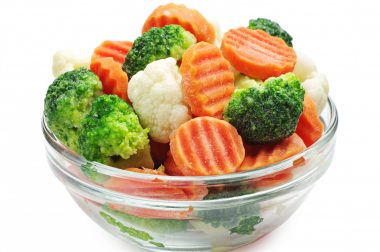A short heat process known as blanching is generally recommended before freezing of vegetables. Some canning recipes also call for a short blanching, or heating, step prior to placing vegetables into the jar. Blanching helps to stabilize the color, especially of peas and other green vegetables, and it protects flavor and texture. Blanching also helps to cleanse the surface of vegetables by destroying microorganisms on the surface, and it wilts or softens vegetables to make them easier to pack. Blanching can also protect vitamins that might be lost during freezing.
There are two standard methods of blanching: water blanching and steam blanching. For home freezing, most vegetables benefit from blanching in boiling water. For best results, use a pot that has a blanching basket and cover, or fit a wire basket into a large pot with a lid. Use one gallon water per pound of prepared vegetables. Put the vegetable in a blanching basket, lower into vigorously boiling water, and cover the pot with a tight-fitting lid. The water should return to boiling within 1 minute, or you are using too much vegetable for the amount of boiling water. Start counting blanching time as soon as the water returns to a boil. Keep heat high for the time given in the directions for the vegetable you are freezing. Heating in steam is recommended for a few vegetables. For broccoli, pumpkin, sweet potatoes, and winter squash, both steaming and boiling are satisfactory methods. Steam blanching takes about 1½ times longer than water blanching. To steam, use a pot with a tight lid and a basket that holds the food at least three inches above the bottom of the pot. Put an inch or two of water in the pot and bring the water to a boil. Put the vegetables in the basket in a single layer so that steam reaches all parts quickly. Cover the pot and keep heat high. Start counting steaming time as soon as the lid is on.
Tips on blanching for the best quality frozen vegetables. Blanching time is crucial and varies with the vegetable and size. Under-blanching stimulates the activity of enzymes, proteins that cause changes in color, texture, flavor, and nutrients, and is worse than not blanching at all. Over-blanching causes loss of flavor, color, vitamins, and minerals. Follow these blanching tips for high quality frozen vegetables:
- Don’t overload the process. Processing small quantities at a time, generally 1 pound of prepared vegetables, will mean that water returns to a boil quickly (within 1 minute) after vegetables are added.
- Use either steam or hot water for blanching; avoid microwave blanching.
- Follow stated blanching times. Use tested recipes for best quality; start timing the blanching process as soon as water is boiling (or steam is being produced). See the Division of Extension publication Freezing Fruits and Vegetables or the National Center for Home Food Preservation for tested recipes for home freezing.
- Cool immediately once heating is complete. Once blanching time is up, it’s important to stop the heating process. To cool, plunge vegetables into a bowl of icy water. The Rule of Thumb is cooling time = blanching time. If you blanch something for 1 minute in boiling water, then cool it for 1 minute in ice water – followed by draining.
- Drain cooled vegetables prior to packing for the freezer. Excess moisture can cause loss of quality when vegetables are frozen.
While most vegetables should be blanched prior to freezing, there are some exceptions: peppers do not need a blanching step, and some items such as potatoes are better prepared by par-cooking in an oven, rather than blanching, prior to freezing. Fruits do not need to be blanched (heat treated) prior to freezing. And if you choose to place items in the freezer without blanching, it’s a quality issue, not a food safety concern. The items that you freeze without blanching may look and taste bad, but omitting the blanching step is not a direct cause of foodborne illness. Stay food safe!




